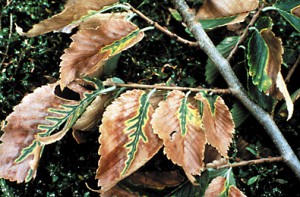The bacterium is Xylella fastidiosa, which invades the sap-conducting xylem cells, is associated with a leaf scorch of at least five tree species.
Bacterial leaf scorch affects elms and several species in the red and black oak group including northern red oak, Quercus rubra; pin oak, Q. palustirs; scarlet oak,
- coccinea; southern red oak, Q. falcata; laurel oak, Q. laurifolia; shingle oak,
- imbricaria; and the black/water oak, Q. nigra, sycamore, maple, mulberry, plum and citrus are also susceptible.
Bacterial leaf scorch has been observed most often in the mid-Atlantic and southeastern states. However, oak leaf scorch has been seen as far north as New York; affected sycamores are common in Texas; and diseased mulberries have been seen as far west as Nebraska. These diseases have been detected in other regions.
Environmental factors such as drought, excessive salt, or root damage have long been known to cause abiotic leaf scorch. These factors exacerbate bacterial leaf scorch.
Xylem-feeding leafhoppers transmit X. fastidiosa. In a typical life cycle, marginal leaf scorch symptoms begin to develop in mid-to-late June and increase in severity throughout summer and early fall. Scorch appears as an irregular, scalloped browning along the leaf margin and may be bordered by a yellow halo. As browning spreads toward the mid-vein, leaves may curl and drop early. Symptom severity progresses from older to younger leaves on a branch; newest leaves at the tip sometimes remain unaffected. Symptoms recur each year and spread over the tree’s crown. Chronic infection results in branch dieback, crown decline and death.


